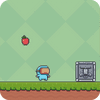The battles and moving viewpoints that birthed Humanity
This interview has actually been modified for clearness
You are radiant. You radiate beauty. You are an animal.
To be more specific, you are a golden Shiba Inu who is responsible for leading an endless stream of souls to the light at the very end of the planet. It’s now quite windy. You’ll be a lock for Employee of the Month if you only yell a few directions at your unusually devoted performers to help them get over a few simple barriers.
But, contrary to its name, humanity very quickly develops into a complex creature. You’ll soon be using a changing list of absurd commands to get around increasingly dangerous obstacles (such angry mobs and floating bodies of water) and create living Rube Goldberg machines that will make you believe in the power of omnipotence.
Anyone who is familiar with the talented groups who make up Mankind would, in fact, expect nothing less. The video game is the result of a collaboration between Enhance, the creator of Tetris Effect Lumines and Rez, and Tha Ltd, an interactive style studio with headquarters in Tokyo.
The job was first conceived when Yugo Nakamura, the designer of Tha, pondered the question, “How many digital people can we put on-screen at once?” In an effort to get a reaction, Nakamura created a tech demonstration that caught the attention of Tetsuya Mizuguchi, the veteran designer and developer of Enhance, who was strangely intrigued to the idea and Nakamura’s search for something greater.
Every canine has their day
“Yugo-san is very well-liked and respected in his line of business. He is more than just a designer. He has been gaining experiences as well. I simply thought there needs to be something behind his placing all of those individuals on screen when I saw the demonstration because I am aware of his past and the depth of his work. According to me, [the demo] couldn’t have been the end of the story,” Mizuguchi said in a Game Developer interview.
Mizuguchi claims he wanted to “gear up” Nakamura with the necessary resources to turn that fledgling tech demonstration into a cohesive experience, but he also says it was his responsibility to push the seasoned programmer to continue building on “the little thing I saw” all those years ago.
Production was heavily dependent on trial-and-error and, in some circumstances, acrimonious collaboration, mirroring the character of the video game itself. Regarding the broader creative perspective that guides the majority of their work, Nakamura claims that they personally strive to have an immediate impact on people, but that this approach may frequently have been ineffective when attempting to clarify an ambiguous technological demonstration. “The more I think about what I’m doing, the harder I want to push it. Since I think I can maximise its effect by doing that,” they claim. “If I were to talk to you about people falling, it might look and sound vicious, but I’m still going to pursue it because I want to make people feel something,” he said. While acknowledging that they and Enhance engaged in a bit of a tug-of-war throughout development, Nakamura praises the studio and Mizuguchi for providing “balance.”

Mizuguchi claims that after reading the discussion that the necessary elements were already in place, but that Enhance still needed to help Nakamura find the fun. He describes the Shiba character as the “missing link” that helped bridge the gap between players and the puzzle phases, grounding them in Humankind’s surreal universe by offering a (meta)physical presence. This brilliant idea was “dropped in one day” by Nakamura. By requiring players to manually position and remove each guideline on specific tiles within phases, the myriad of commands (turn, float, dive, battle, split, and more) helped in some light platforming and contributed to giving the gameplay more weight and seriousness.
We thought, “Okay, we have these active elements, but how do we combine it to avoid the monotony of playing a puzzle video game? We had to maintain this balance throughout that process, but our user screening process really helped us,” says Mizuguchi. It took a tonne of work, but we were able to trim the fat and create something that was, if I do say so myself, rather progressive.
Mayhem and cohesion
A sequence of brutalist phases that gradually introduce new dangers, mechanisms, and powers create problems for humanity. Some are very important, while others are completely optional. However, you’ll need to unwind them all if you want to collect every single Goldy—enforcing humanoids made of the most expensive of metals. It’s a perplexing slalom that takes pleasure in making players feel absurdly thick before rewarding their perseverance with numerous, endorphin-boosting epiphany moments.
Mankind’s true beauty lies in how skillfully it scales to ensure that players never experience overstuffing. You never feel cheated, not even when it’s the most disheartening. Strong versions from both groups were required to strengthen that development curve. Level style is “simply actually, truly hard,” as Nakamura puts it. Tha took the lead in developing Humankind’s phases, but she soon realised that the work was almost “difficult.” When Nakamura truly came to a standstill, he turned to Enhance for assistance, and the result was a series of phases that were successful in perplexing the designers themselves.
One level in particular caught Nakamura off guard to the extent where they assumed a bug was to blame. They “repaired it” and informed the responsible designer, only to discover a fairly obvious solution that had actually been staring them in the face all along. Simply shifting your perspective will make everything fall into place, according to Nakamura.

It’s excellent advice for gamers, but when a task is so close at hand, it might be difficult to change your perspective. While design is crucial, Mark MacDonald, an executive manufacturer at Enhance, explains that changing just one level might “alter the whole scope” of the game. Hammering home Mizuguchi’s earlier points, he added that screening was worth its weight in gold to the development team since it allowed them to view the project with new eyes.
“Screening was so extensive because it’s like hearing the same joke a thousand times. You are no longer able to discern whether it is humorous. You don’t realise how difficult a task is anymore, claims MacDonald. Different people also approach problem-solving in different ways, thus throughout testing we were able to tell apart between those who would respect the challenge more, who didn’t want any help, and people who are genuinely quick to give up.
The team includes features like option videos that can be accessible through the time out menu in order to cater to the needs of different players. They also decided to make some of the trickier phases optional, but they used the allure of Goldys, which are needed to open bonus offer items and further phases, to draw players in. The end result is that people can, to a certain extent, handle their own problems.

MacDonald recalls that other levels also seemed to have a widespread appeal, so the team started to dissect those fan favourites to discover their inner workings. “‘Loop the Loop’ is one of the levels we mention frequently early on and is present in both the demonstration and the final video game (notice how each title also provides a tip). When we first realised that everyone enjoyed that level, he says, “we sat down and dissected it piece by piece, and the result was a great deal of understanding.
“For instance, with that level in particular, you genuinely seem to have discovered something—namely, the capacity to create these tiny loops to maintain switches turned. There was a ‘a-ha!’ moment because it teaches you a completely new technique. Importantly, you were aware that if you discovered the solution, there might be a way to reverse it and sort of cheese the phase, but it was also obvious when you had done so. It didn’t matter if players “cheesed” their way to victory or adjusted the level the way the developers intended because in both cases, players had to be “deliberate.” That was a crucial piece of the puzzle in MacDonald’s eyes.
Oh, the Humanity!
Returning to the original tech demonstration that first captured Mizuguchi’s imagination, the team believed it was crucial for players to connect with their group of people but acknowledged they couldn’t force them to save everyone. There were times during my playthrough when I made the decision to sacrifice some of my beloved flock for the greater good. Although I didn’t enjoy marching them into the void, watching them melt into specks of eternal light before falling to the ground made me feel much better about the entire experience.
There is no rating that tracks how many people you are losing, according to MacDonald. For Yugo-san and Miz, this was a crucial item. There is no countdown timer or counter that shows how many souls you have lost. He says that one of the “huge things” the group agreed on was that failure should be seen as a springboard for progress rather than a punishment. It also works. In the midst of Mankind’s chaos, there is a sense of tranquilly since it is immediately understood that some services require sacrifice.

“Retrying is the point. We want to emphasise early on that people aren’t dying because of this. They’re not splatting on the floor on purpose. We spent a lot of time fine-tuning the outcome and the messaging there. In some ways, we want people to feel something when they witness people being crushed, but we didn’t want people to experience this terrible burden of responsibility. Simply put, the team needed to give people the confidence to leave some regrettable losers behind, whether it be because they were trampled under a falling block or told to continually step over a switch. Did they have any success? Why don’t you ask the 100 people I unintentionally punted against a solid wall.
I realise that sounds a lot like mass murder, but in the grand scheme of things, Mankind has committed far worse crimes. We query whether the group eventually reached a limit in light of Nakamura’s choice to include as many people as possible on screen. “We need to look at and consider it because we do have a PS4 SKU and a minimum spec PC SKU. According to MacDonald, “I think the majority of the levels can accommodate about 5,000 people, and I think there’s one special level where that increases to 10,000,” which helps me feel a little better about some of my more expensive experiments.
We’re all part of the loop
We ask Nakamura how it felt to transition from working in the fashion industry to full-fledged video game development near the end of our discussion. They suggest somewhat frankly that if they had known how much Humankind would have demanded, they might not have created it.
In contrast, Nakamura says that while constructing a website, for instance, they know when to quit. The goal has been accomplished if they are happy and the consumer is more than satisfied. Video game creation is rarely that simple. The bar is where? What is the point of completion? I wasn’t aware of how far you needed to push it, says Nakamura. “There was just this constant feeling of tension and not understanding what the completion objective was because I could not see the goal.” He likens the development of video games to exploring unexplored oceans in the past without knowing if you’ll hit land or simply fall over the edge of the planet.
“Even with the video game being released, I’m not sure if it’s truly fun or if it’s hitting that threshold. In their efforts to guide me, Miz, Mark, and the rest of the group almost succeeded in acting as a satellite for me. Despite the fact that it wasn’t always easy sailing, Nakamura claimed that beginning this trip as an amateur and ultimately plotting a course to launch has really given him a sense of joy and fulfilment that is “inexpressible.”

In terms of Mizuguchi, embracing his new role as a maker has allowed him to introduce more novel experiences into the globe. He talks about a synesthesia game and a synesthesia “chair gadget” that he’s also been working on. Obviously, not all of them are related to video games, but he thinks that each one, Mankind included, would let consumers feel something.
He claims that “my goal and my goal has actually always been to incorporate this synesthesia style and component into an experience.” “I can say with certainty that this is my life’s work, and I’m devoting every ounce of my might to making these experiences public. […] Each experience I create also becomes a component of a larger loop that enlarges even more as technology develops.
“I’ve found that creating and having such experiences makes me happy.Tetris Effect is a great illustration of how all those factors come together, but from what I gather, technology will only help us increase the variety of the psychological journeys we can take people on.I just have so much power. Because I can just create so many experiences while I’m around, I’ve surrounded myself with people who share my orientation towards potential. That is my motivation. What keeps me going is that loop.
“

























